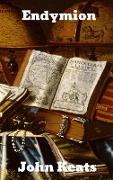- Start
- Endymion
Endymion
Angebote / Angebote:
Endymion is a poem by John Keats first published in 1818. It begins with the line "A thing of beauty is a joy for ever". Keats based the poem on the Greek myth of Endymion, the shepherd beloved by the moon goddess Selene. The poem elaborates on the original story and renames Selene "Cynthia" (an alternative name for Artemis)It starts by painting a rustic scene of trees, rivers, shepherds, and sheep. The shepherds gather around an altar and pray to Pan, god of shepherds and flocks. As the youths sing and dance, the elder men sit and talk about what life would be like in the shades of Elysium. However, Endymion, the "brain-sick shepherd-prince" of Mt. Latmos, is in a trancelike state, and not participating in their discourse. His sister, Peona, takes him away and brings him to her resting place where he sleeps. After he wakes, he tells Peona of his encounter with Cynthia, and how much he loved her.The poem is divided into four books, each approximately 1000 lines long. Book I gives Endymion's account of his dreams and experiences, as related to Peona, which provides the background for the rest of the poem. In Book II, Endymion ventures into the underworld in search of his love. He encounters Adonis and Venus-a pairing of mortal and immortal-apparently foreshadowing a similar destiny for the mortal Endymion and his immortal paramour. Book III reveals Endymion's enduring love, and he begs the Moon not to torment him any longer as he journeys through a watery void on the sea floor. There he meets Glaucus, freeing the god from a thousand years of imprisonment by the witch Circe. Book IV, "And so he groan'd, as one by beauty slain." Endymion falls in love with a beautiful Indian maiden. Both ride winged black steeds to Mount Olympus where Cynthia awaits, only for Endymion to forsake the goddess for his new, mortal, love. Endymion and the Indian girl return to earth, the latter saying she cannot be his love. He is miserable, 'til quite suddenly he comes upon the Indian maiden again and she reveals that she is in fact Cynthia. She then tells him of how she tried to forget him, to move on, but that in the end, "'There is not one, / No, no, not one/ But thee.'"John Keats (31 October 1795 - 23 February 1821) was an English Romantic poet. He was one of the main figures of the second generation of Romantic poets, along with Lord Byron and Percy Bysshe Shelley, despite his works having been in publication for only four years before his death from tuberculosis at the age of 25. Although his poems were not generally well received by critics during his lifetime, his reputation grew after his death, and by the end of the 19th century, he had become one of the most beloved of all English poets. He had a significant influence on a diverse range of poets and writers. Jorge Luis Borges stated that his first encounter with Keats' work was the most significant literary experience of his life.The poetry of Keats is characterised by sensual imagery, most notably in the series of odes. This is typical of romantic poets, as they aimed to accentuate extreme emotion through an emphasis on natural imagery.
Fremdlagertitel. Lieferzeit unbestimmt
